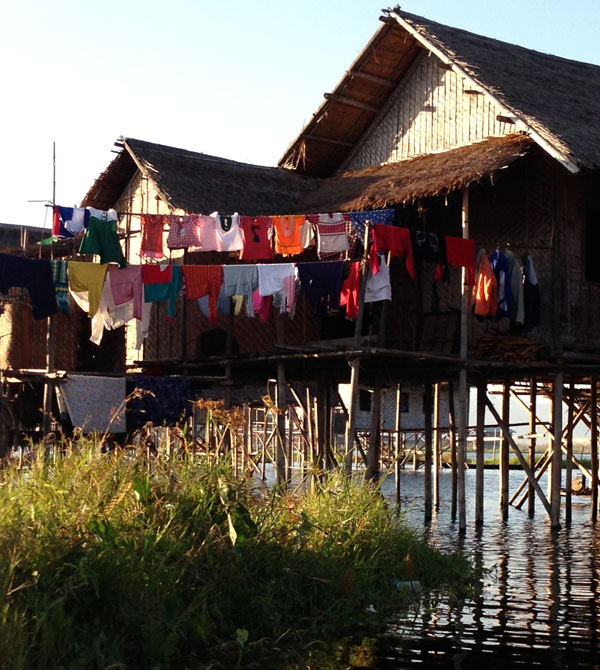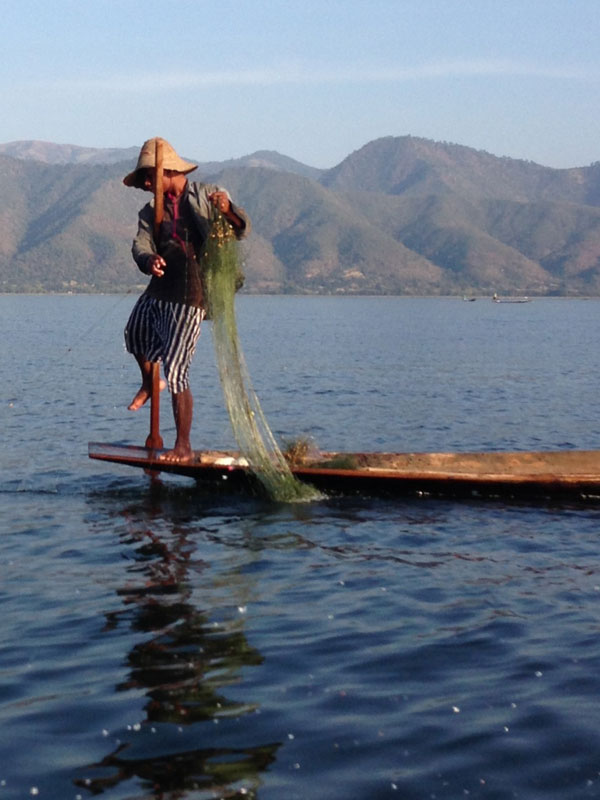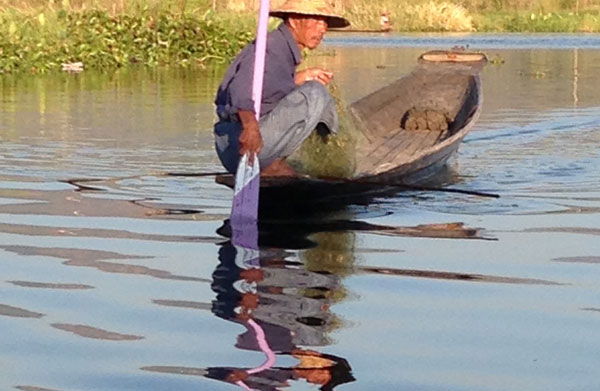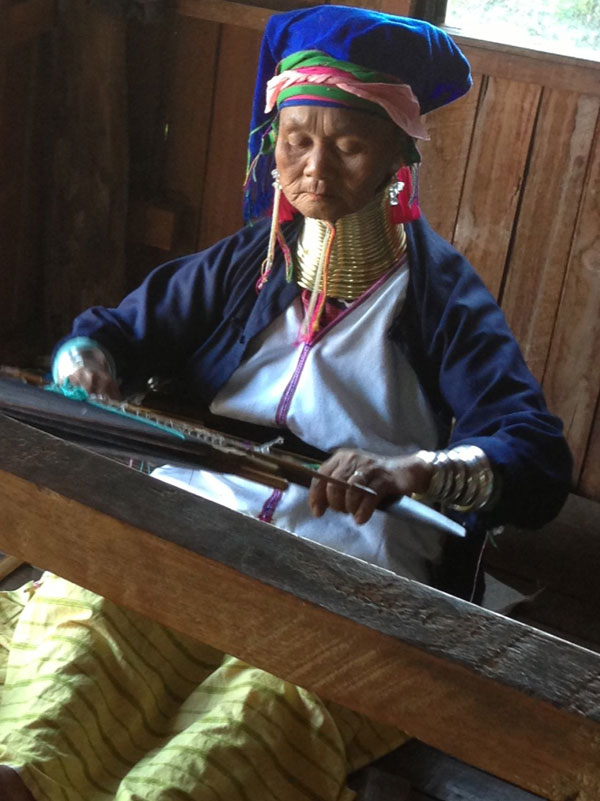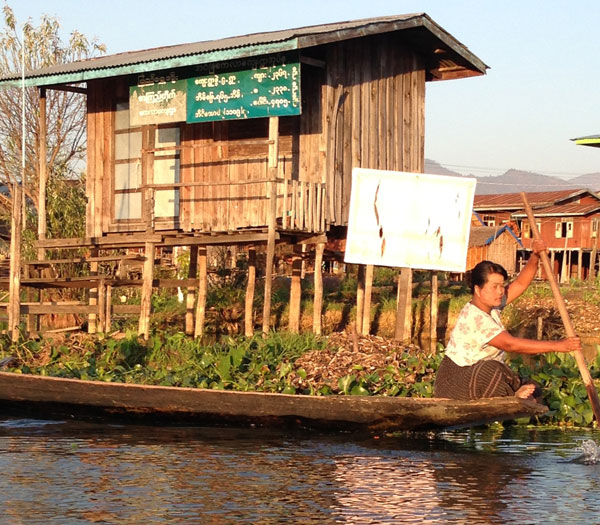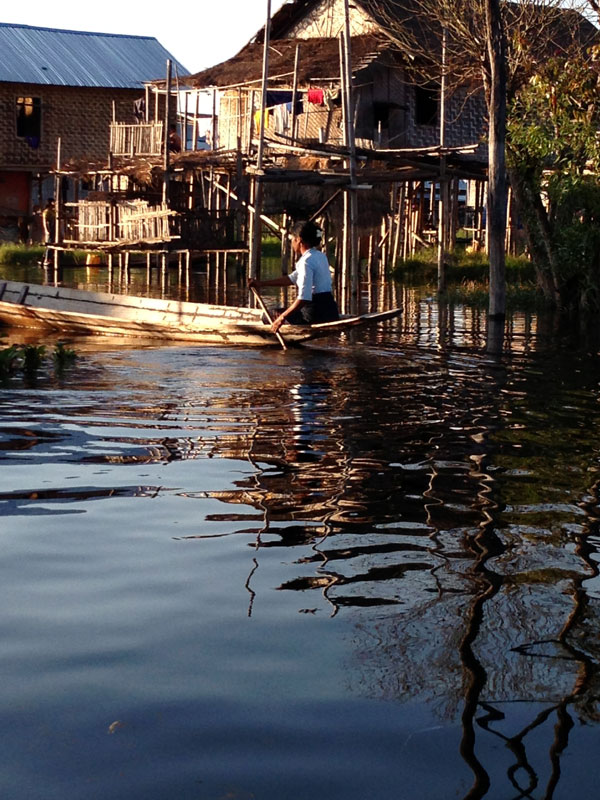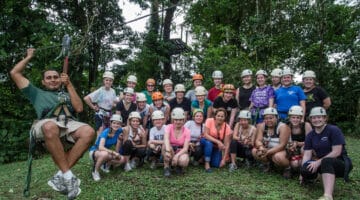Educational Travel | Life-Changing Moments at Inle Lake

I am getting to love the airplanes. Clunky old propeller planes that fly at a maximum of 11,000. It’s a sightseeing tour as you can see most everything up there. The service is nice, too. The flight attendants are friendly. United and American take note!
The whole process of flying is different. Everyone gets a sticker to show which airline you are taking. Rangoon was ours. There’s no need to carry on your main bag. First, no room. Second, it doesn’t take long from plane to arrival building. A guy carries it to you. And don’t worry about separating your liquids. I did and the guy at the X-ray machine thought I was weird by showing him my toothpaste and toiletries. That’s stuff you don’t have to worry about when you’re flying in Burma.
The flight from Mandalay to Heho near Inle Lake was 25 minutes. And in that time you get a freshener wipe and a drink of juice. Open seating, but no hassles. These are the friendly skies.
Inle Lake Arrival
It all starts when you jump in the long tail boats at the main town of Nyaung Schwe. It reminds me of a primitive Piazzale Roma in Venice. It’s the last point where you see cars and trucks. From now on, everything is based around boat transportation of one kind or another.
Cutting through the floating fields of lotus flowers and water lilies the journey begins. There is no sense of what is. The boat moves at a fair clip en route to the hotel. Suddenly you are out of the narrow channel and into the main body of this huge and beautiful lake.
Lots of fishing boats are out on the lake. Long teak flat boats that sit low in the water with fisherman navigating using a strange movement with a pole seemingly wrapped around their leg. They crouch at the very end of the boat, but the teak is so heavy it remains steady.
The hotel is a beautiful place. The Inle Lake view hotel. Water buffalo are taking a bath in the channel by the dock. Check in is fast and out we head to the villages that are around the perimeter of the lake.
All the houses are on stilts. Sanitation is central to the cleanliness of the lake and they have this truly figured out. There are schools, literally floating schools, and gardens that produce tons of produce. All grown on a floating mesh of water lily and water hyacinth.
The floating islands are held by bamboo poles that are sticking out and sticking into the mud below. Bamboo is everywhere. I have never seen so many tomatoes in my life. Thousands of them, row upon row of vines, all perfectly maintained on the floating garden.
Fishing is central to the industry of the lake and everyone has a teak boat. It’s the only way to see your neighbors. This is a rural community, but not a poor community. It grows its own produce, catches its fish and much of the produce is sold many miles away. It’s the breadbasket of Burma. The sights are incredible. Picture postcard stuff.
The camera is crying for a break! Not today.
Another day on the lake. Today we head out to the far reaches of the lake. It will be a 45 minute journey and the day starts early. The teak boats are out in the middle. The fisherman take turns to slap the water with their oars to cluster the fish. It’s a simple method, but seems to work well.
As we speed across the central part of the lake we enter another channel. So begins a long journey. A snake slithers by in the shallows by the banks and there are lots of wooden bridges joining up the floating islands.
The journey today is to the Indein ruins…there are over 1,000 pagodas dating back to the 8th century. The boat pulls into a tiny village with a cluster of souvenir shops selling the usual straw hats and jewelry. And then a complete surprise. It’s a celebration of independence day for Burma. There are sports events in the village school and the kids are in 3-legged relay races and the like.
Then there’s a guy with a very dangerous sword who under full drum roll slices a cucumber, or rather, dices a cucumber that’s sitting precariously on one of the kid’s necks. Thank goodness he is good.
Bought some nut brittle and walked across an old wooden bridge. It was water buffalo washing time. Bit like a car wash really. Got to keep the machinery clean! On to the temples. I mean. I have now seen 100,000 of these stupas or pagodas or temples and yet they remain as fascinating as ever. Some are in pretty bad disrepair here. It’s a sea of gold leaf turrets It’s amazing.
Head back to the lake and went to see a silk weaving factory and then had a late lunch. At the lunch place there were three weavers who belong to the Paduang tribe. This is the tribe whose woman wear bronze rings around their necks. They start at age 5 and as they grow, another ring is added. It is said that they did this originally because the neck is the most vulnerable part of our body. It began as a form of protection against leopards, and since has turned into a ritual considered to be a beautiful adornment for woman. They are often called giraffe neck women. It is absolutely bizarre. I remember when I was a kid in school seeing photographs of these woman. I never imagined I would come face to face with one.
A travel moment. Burma is full of them.

